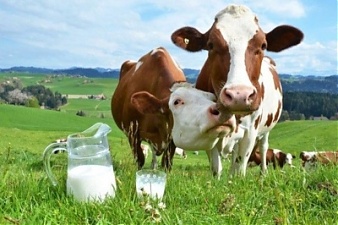Agriculture, Covid-19, Employment, Estonia, Markets and Companies, Transport
International Internet Magazine. Baltic States news & analytics
Tuesday, 16.12.2025, 02:28
Border closures have exacerbated labor shortage on Estonian dairy farms
 Print version
Print version |
|---|
According to the chamber, there are currently approximately 400 foreign workers on Estonian dairy farms. Roomet Sormus, chairman of the management board of the Chamber of Agriculture and Commerce, said that the entire agricultural sector urgently needs foreign labor to help the locals.
"A survey conducted by the Chamber of Agriculture among dairy farmers in April showed that, in larger dairy herds, one in five farm workers come from Ukraine, including one in three milkers from across the border. In summary, the milking of a quarter of Estonian cows depends on foreign labor," Sormus said in a press release.
Elke Lillemets, member of the management board of the Estonian Strawberry Farmers Association, said in a press release that the problem is by no means limited to one area of agriculture, strawberry farming. "The strawberry season is short, the milk season is year-round. It is completely incomprehensible to me how it is possible not to understand the problem, deny it and offer solutions that cannot be implemented," Lillemets said.
Sormus said that as of the end of March this year, there were 86,000 dairy cows in Estonia. "Last year, we produced 821,500 tons of milk, a number that has grown steadily. The increase is due to the increase in the productivity of dairy cows, last year, one cow produced an average of 9,633 kilograms of milk," he added.
He noted that dairy farming is also one of the main export branches of Estonian agriculture. "In 2019, 194.5 million euros' worth of milk and dairy products were sold out of Estonia. A simple calculation shows that 49 million euros depend on the country's export income from foreign labor in the dairy sector alone," Sormus said. He added that the country's total agricultural output last year was just over a billion euros, of which milk accounted for approximately a quarter.
According to Sormus, farmers produced 249 million euros' worth of milk in 2019. He added that approximately a quarter of the sales revenue of the dairy industry also depends on foreign milkers, because if there is no raw material, there is no point in turning on production lines.
According to the survey by the Chamber of Agriculture and Commerce, the average gross salary of an Estonian milker is 1,150 to 1,200 euros per month. The majority of employees in Estonian dairy farms are still Estonians, but agricultural entrepreneurs are concerned about the aging of the workforce. For example, the share of the 50-70 age group in employment in the agricultural, forestry and fisheries sectors was 44 percent last year, while in the early 2000s the share of this age group was 33%.
"The survey by the Chamber of Agriculture and Commerce found that more than 40 percent of dairy farmers have never been able to find a farm worker with the help of the Unemployment Insurance Fund, but about a quarter of farmers have sometimes succeeded. I believe that this does not show the poor work of the Unemployment Insurance Fund, but too little interest in working in agriculture," Sormus said.
Raimond Strastin, head of the Gardening Association, said that he can somewhat agree that labor shortages in agriculture have been caused by too low wages. But it is not necessarily possible for producers to remain profitable in the event of a wage increase. "Production costs for farmers have risen steadily, but unfortunately the selling price of produce has not kept pace," Strastin said in a press release.
Sormus said that the price of milk has fallen in the last few months. "At the same time, labor costs in the agricultural sector have increased 1.5 times in a decade -- in 2008, they were 116 million euros, while last year, already 174 million euros," he added.
Sormus added that the shortage of milkers has led to wage levels of up to 1,600 euros on some farms. "The study also confirms that Ukrainian milkers are usually not paid less than Estonian milkers. So, it is not a matter of cheap labor -- there are simply not enough workers who are passionate about animal husbandry," he said.
The Chamber of Agriculture and Commerce said that, according to Statistics Estonia, the average median gross salary of all activities was 1,143 euros in 2019, while the average unskilled farm worker earned 834 euros and the average skilled animal husbandry worker -- for example a milker -- 1,018 euros.
- 28.01.2022 BONO aims at a billion!
- 30.12.2020 Накануне 25-летия Балтийский курс/The Baltic Course уходит с рынка деловых СМИ
- 30.12.2020 On the verge of its 25th anniversary, The Baltic Course leaves business media market
- 30.12.2020 Hotels showing strong interest in providing self-isolation service
- 30.12.2020 EU to buy additional 100 mln doses of coronavirus vaccine
- 30.12.2020 ЕС закупит 100 млн. дополнительных доз вакцины Biontech и Pfizer
- 29.12.2020 В Латвии вводят комендантский час, ЧС продлена до 7 февраля
- 29.12.2020 Latvia to impose curfew, state of emergency to be extended until February 7
- 29.12.2020 Number of new companies registered in Estonia up in 2020
- 29.12.2020 В Риге можно изолироваться в трех гостиницах








 «The Baltic Course» Is Sold and Stays in Business!
«The Baltic Course» Is Sold and Stays in Business!

